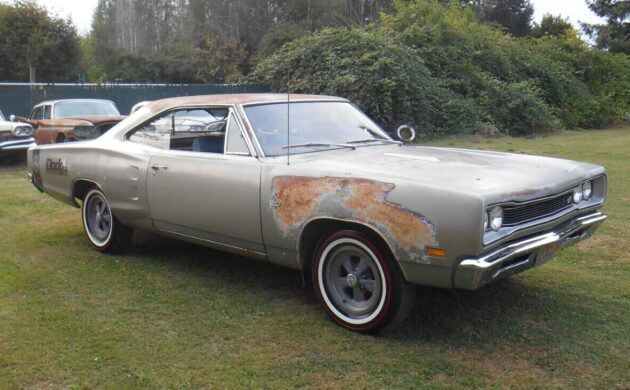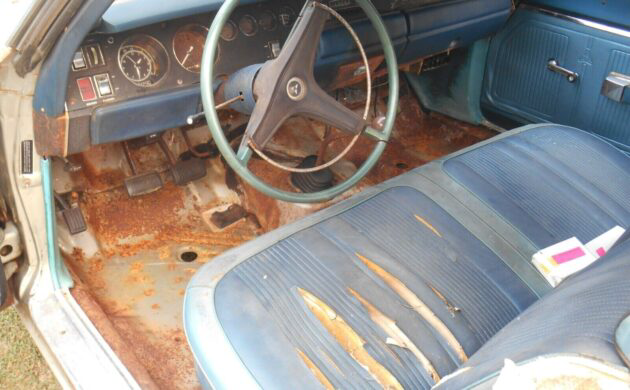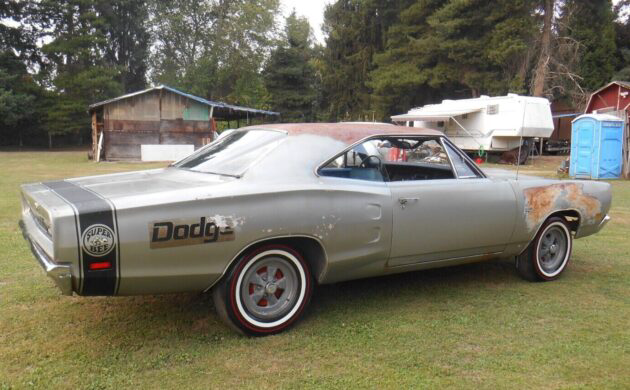Parked in 1979: 1969 Dodge Super Bee
This 1969 Dodge Super Bee confirms that desirable classics are languishing in barns and sheds, just waiting to be liberated and returned to their rightful place on our roads. This beast had only ten years of active service under its belt before its hibernation began. It recently emerged into the light of day, ready for a new owner to return it to its former glory. It is missing a few small pieces but is essentially complete and rock-solid. The Dodge is listed here on eBay in Woodinville, Washington. Bidding sits below the reserve at $21,100 but has reached that figure following frantic activity.
Dodge introduced the Super Bee for the 1968 model year, with the badge remaining in showrooms in North America until 1971. It disappeared for decades but was revived in 2007. Our feature car is from the second production year, with its original owner ordering it in Code A4 Silver. It looks tired and neglected now, but you need to probe below the surface to discover it is a diamond in the rough. The seller supplies some excellent shots of the floors, trunk pan, and underside. They reveal some pretty heavy surface corrosion but no apparent penetrating rust. The new owner will almost certainly elect to undertake a nut-and-bolt approach to the restoration, and mounting it on a rotisserie would be an ideal way to completely eliminate the corrosion to ensure no future problems. The panels have repairable bumps and bruises, but the overall impression is that there won’t be much cutting or welding in this Dodge’s future. The trim condition ranges between acceptable and restorable, and the glass looks okay. The Super Bee rolls on a set of vintage Cragar wheels that may respond positively to restoration. A perfectionist might seek the correct wheels to return the car to its factory specifications.
The interior shots leave me scratching my head about one aspect, but I’ll get to that shortly. The lack of carpet makes examining the floors easy, and there are no issues beyond surface corrosion. The rear seat back is missing, but the inside of this classic is otherwise complete and unmolested. The dash needs love, the car requires a retrim, and the painted surfaces are begging for a refresh. Nothing is unusual until we turn our attention to the gauges. The original owner selected the desirable Tick-Tock-Tach, which is intact and in reasonable order. However, the other gauge faces are covered in weird corrosion that obscures the markings. I can’t think of a plausible explanation for this, but I think they are beyond salvation. Therefore, the new owner needs to factor the cost of replacements into their build budget.
The entry-level V8 in the 1969 Super Bee was the company’s 383ci V8. It provided the performance most buyers craved, pumping out 335hp and 425 ft/lbs of torque. Owners could extract the maximum from this powerplant by specifying a four-speed manual transmission and a 3.91 Sure Grip rear end. Those were the options this classic’s first owner selected, allowing this ground-bound jet to scorch the ¼-mile in 14.4 seconds. The seller confirms this Dodge is numbers-matching. It is missing some items, like the original radiator, but they are working to obtain these from the previous owner. There are no prizes for guessing it doesn’t run or drive. Revival might be possible if the engine turns freely, but budgeting for a rebuild would be the best way to do justice to a classic of this caliber.
I admit I’ve looked at some project candidates we’ve featured and pondered whether they had deteriorated beyond the point of no return. I have no qualms with this 1969 Super Bee, nor do the twelve people who have submitted thirty-six bids in the auction’s first two days. People like what they see and are willing to vote with their wallets. This is a chance for you to have your say. How many bids will be submitted before the hammer falls? More crucially, what will the price be? It will be fascinating to see if anyone nails this one.
Auctions Ending Soon
 1971 Ford Mustang Mach 1Bid Now19 hours$7,100
1971 Ford Mustang Mach 1Bid Now19 hours$7,100
 2003 Porsche Boxster SBid Now20 hours$6,000
2003 Porsche Boxster SBid Now20 hours$6,000
 1966 Lincoln ContinentalBid Now22 hours$500
1966 Lincoln ContinentalBid Now22 hours$500
 2000 Jaguar XJ8LBid Now4 days$1,250
2000 Jaguar XJ8LBid Now4 days$1,250
 1977 Datsun 280ZBid Now5 days$275
1977 Datsun 280ZBid Now5 days$275






Comments
The “wierd corrosion” on the gauge faces is RUST, which along w/ the condition of the shiifter & turn signal stalk, and what can be seen of the under dash components indicates water intrusion (IMO). This car IS salvageable, but I suspect that a completely new wiring harness would also need to be factored into the restoration costs. GLWTA!! :-)
That’s a rough 10 years. I daily drive a 26 year old Plymouth with zero rust. This Bee shows how poorly Chrysler built cars in the late 60s. While in college, I bought a B5 blue 68 two door hardtop Satellite. It already had rot in the quarters. And the original owner lady’s husband was the body shop manager where I worked detailing cars . I paid $600 for the car. That was in 1979.
I have restored cars with that kind of corrosion and they have all been flood cars. Possible typhoon flooding damage? But I am not sure if they get that kind of weather in Washington state. But that is still no reason not to save it.
Get those stupid looking wheels and tires off!
Those whitewalls would be the first thing to go for me. I just do not understand the fascination.
I agree with Orlan.
I believe this was in a flood.
Look at those gauges, looks like water got into them and created that rust.
Also carpet out was probably destroyed in flood.
Still love to see this Super Bee restored.
Borderline restore-able. Or a great collection of parts as a doner. The 4 speed is what saves it.
21k for a donor? Hmm. Ok.
According to the Super Bee registry they made 15 4 speed cars in silver with the 383 that explains the price.
If memory serves, the tick-tock-tach had plastic faces where every other gauge was metal. At issue is that the clock and tach mechanisms are metal and likely rusted as well, even if the faces look good.
Very handsome car, even as is. One of the best of the era.
This car has been underwater, which probably is what got it parked after only 10 years on the road to never be driven again. Dash gauges do not rust over like this one unless they’ve been filled with water, and the only way that can happen – since it’s not a ragtop – is for the car to have gone for a dip. The damage to the right fender looks like where it came to rest against the lake or river bed. When they pulled it up out of the water, they stripped the soaked carpet out and hosed it down as best they could to get the silt and weeds off of it – let it all dry and then tried to get it to run. When it wouldn’t – it got parked and stored – hoping to get to it “some day” to restore it. Finally, it got passed on to the one who has it up for auction – and hopefully it will find a home with someone who can bring it back from the dead. This particular Super Bee is a rare one – so if someone restores it to its original grandeur – they will have a very valuable show car and super-fun driver.
Looks like the Car was purchased from Portland swop meet around 4 months ago. There is a short video if you do a search for it. The wheels have been swopped and the original dealer plate surround has been removed.
I’m thinking with all that surface rust it must have sat close to the ocean, not bad though still gonna take about $50,000 / $60,000 to restore if the new owner does most of the work, cool colors but anything over $8000. to start a restoration project is just ridiculous, I’d be willing to bet this one ends up at the auction house
I rarely see any 69 Super Bees come up for sale. Anywhere. Especially, a 4 speed manual. The other comment about it being underwater may be true. Who knows? It’s going to take a chunk of change for a full restoration. A fresh engine, trans and paint would be plenty on top of the sellers price.
Geez, those 10 years that this car was in service before it “went into hibernation”, must have been hard!
Good candidate for Mark Worman